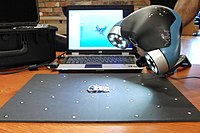
Photo from wikipedia
Abstract A new method was developed for reconstructing the geometric structure of large plants such as trees at the leaf-scale by utilizing terrestrial LiDAR data. The primary goal of the… Click to show full abstract
Abstract A new method was developed for reconstructing the geometric structure of large plants such as trees at the leaf-scale by utilizing terrestrial LiDAR data. The primary goal of the work was to develop a feasible means for accurately and rapidly reconstructing or “digitizing” entire trees in order to specify the position, orientation, and size of every leaf in digital tree models that provide geometric inputs for high-resolution biophysical models or analyses. As with any optical measurement technique, a primary challenge is accurately accounting for plant matter that is occluded from view of the sensor. The present method is termed “semi-direct” because it uses a triangulation procedure to approximately directly reconstruct as many leaves as possible that are in view of the scanner. For plant matter obstructed from view, a statistical backfilling procedure was used to add additional leaves such that the three-dimensional distribution of leaf area and orientation of the reconstructed plant matched that of the actual plant on average. In a best case scenario such as when leaf density is low, nearly all leaf area is directly reconstructed from the scan and the branch and clumping structure is preserved within the reconstruction. In the worst case scenario such as when the leaf density is very high and nearly all leaves are occluded from view of the scanner, only a small fraction of leaves can be directly reconstructed, but at a minimum the distribution of leaf area and the leaf angle distribution across the reconstructed plant will be consistent with that of the actual plant. Unlike many other approaches, the present method does not rely on the woody matter of the plant to provide a skeleton for reconstruction, and can be used in dense plants where little woody matter is visible from the scanner.
Journal Title: Remote Sensing of Environment
Year Published: 2018
Link to full text (if available)
Share on Social Media: Sign Up to like & get
recommendations!